Accessible Alba Iulia – the citadel city in Transylvania
`Put the crucifix away and discard that bulb of garlic – you will not need them in today’s Transylvania, which blows away stereotypes faster than the flapping wings of a bat out of hell. Yes, horses and carts still rumble through the wooded countryside, but they’ll soon share the roads with Uber cabs … Look past Count Dracula T-shirts and you will notice an ever-increasing number of art galleries, good value ski resorts and epic nature tours`, quotes the description of Lonely Planet about Transylvania, recommending Transylvania as the best destination in the world to travel in 2016.
Definitely one of the most beautiful cities in Transylvania, although not as famous as Brasov and Sibiu, Alba Iulia is also the topic of our article today. Let’s see what is memorable about this city and especially how accessible this tourist destination is.
A little bit of history
With a history spreading over many centuries, Alba Iulia is, for Romanians everywhere, more than just a city; it is a symbol of the ideals of unity and identity carried by the Romanian people across the centuries. Its name is associated with the union of Transylvania and Romania, on December 1st, 1918, a moment which marks the beginning of the consolidation of the modern Romanian state. Moreover, December 1st is the date which celebrates the national holiday of Romania and the day when the capital city moves to Alba Iulia, to honor the people and actions contributing to the creation and consolidation of the Romanian nation and state.
The city of Alba Iulia hosts, on the Citadel Hill, the Alba Carolina Fortress, which was built at the beginning of the 18th century. The fortress is a Vauban bastion fortress, with the role of strategic defense fortification of the Habsburg Empire against the military efforts of the Ottoman Empire and also of local consolidation of the Habsburg power.
3 things about accessibility
- Alba Carolina citadel is accessible to persons with special needs – the 27 meter wide fortress ditches were fitted with special alleys for wheelchairs for persons with disabilities. Some of the tourist attractions in the Citadel are: the two bastions, Gates IV, V and VI, Bishop’s Palace – the residence of Transylvanian bishops, the Princely Palace, the Roman-Catholic Cathedral, which was built at the same time with Notre Dame de Paris.
- Alba Iulia is the city of the Great Union, therefore the Citadel also hosts the National Union Museum. But the medieval vestiges are not the only points of interest for tourists, but also the public toilet, which became a tourist attraction per se. The main reason for building the public toilet was to showcase a medieval wall, which belonged to a 17th century flour storehouse, probably an annex of the Princely Palace. The underground toilet is equipped for men, women and disabled persons. It has a large hallway, with benches situated opposite the vestiges. Behind the benches there are three plans of the 17th century Alba Carolina fortress.
- For the past 7 years, Alba Iulia celebrated every December the day of people with disabilities. Hundreds of people attend various cultural events performed by members of associations for people with special needs: Christmas songs concerts, dance moments, handicrafts exhibitions, etc. This proves that the inhabitants of the most important city for Romanian history show a great respect for their fellow inhabitants but also for the tourists everywhere, who come here to learn about an important part of Romanian history.
If Transylvania is also on your travel list, a trip to this wonderful Romanian region must include a visit to Alba Iulia – which is at the same time the city of Romanian union and a landmark on Romania’s accessibility map.





